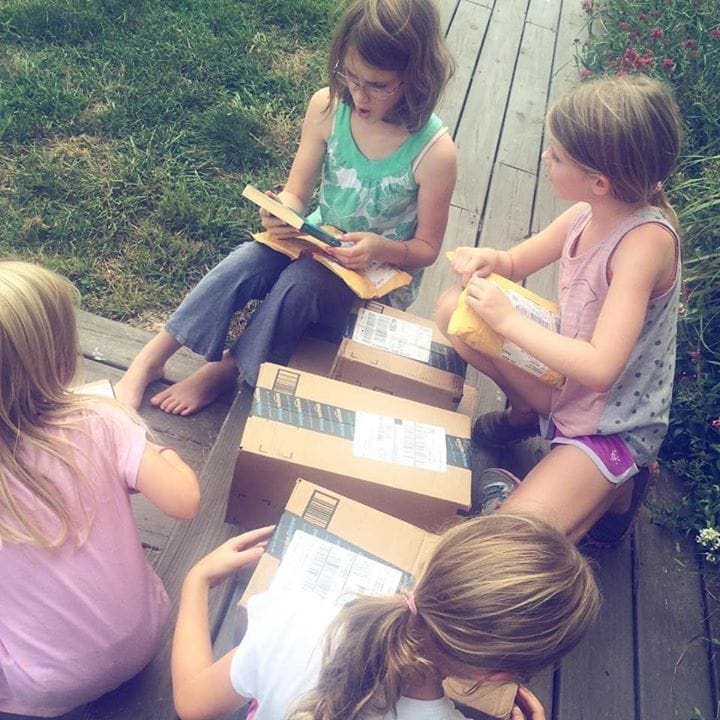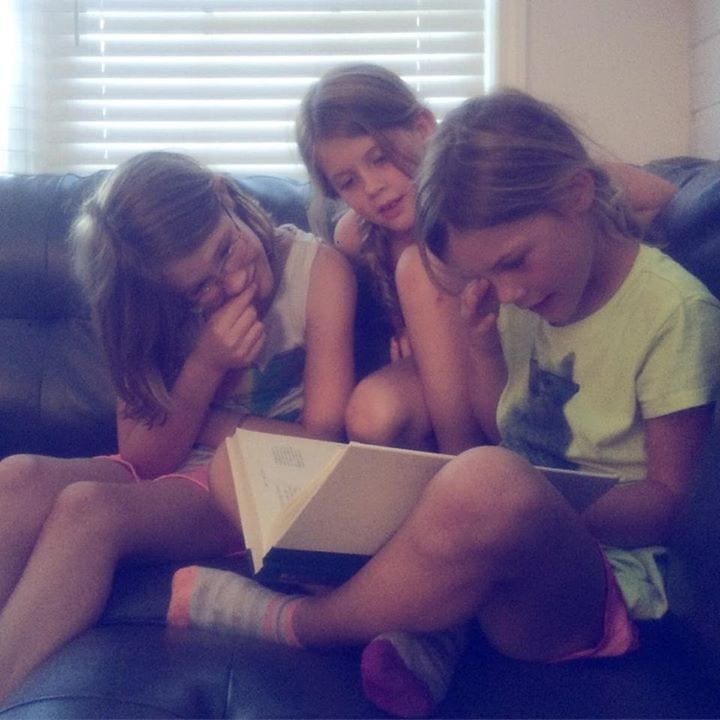
Language arts is one of my very favorite subjects, both as a student myself and as a homeschooler. For that reason, I’ve spent a lot of time considering different curriculum and “perfecting” our approach. (And by perfecting, I mean what we’re doing is working so far for our two oldest…who knows what will happen as the rest of our kids hit middle elementary and beyond!)
First, a little bit about how I learned language arts (which for this post includes reading, spelling, literature, grammar and writing). I attended a Montessori school for 13 years (from 2.5 years old until 8th grade), and I can still vividly remember learning the parts of speech and their symbols—a big red circle over verbs, a big black equilateral triangle over nouns, etc. I can also see the wooden pieces we used for diagramming sentences, although I never really learned to diagram on paper. I learned to read phonetically, but I don’t remember much emphasis on spelling, literature or even writing in school.
In high school and college, I loved writing research papers (but have never really called myself a writer or done it for “fun”), and I’ve always had a pretty good grasp of grammar, even when I didn’t know all of the rules.
NOTE: Understanding proper grammar and choosing to overuse parentheses, ellipses, and exclamation points on your blog and social media posts are two very different things—ha!
When our oldest daughter was a baby, I began working as a general and financial transcriptionist, and I started to learn more about the actual rules of grammar as I worked to properly punctuate the spoken words I was transcribing. I gained a better understanding of the actual rules for semicolons and commas, and—funny enough—I actually fell more in love with the grammar part of the English language.
Which, brings me to homeschooling: my goal has always been to give my kids the tools they need to communicate effectively and intelligently through the written word without making the lessons themselves so dry and boring that they simply hated it. There are still plenty of times that my kids groan over language arts assignments, but for the most part, the older ones have become enthusiastic readers and writers, which is my ultimate goal.
Based on all of the curriculum we’ve tried and reviewed over the years, my gut feeling is that there are a lot of really, really good options out there, with no one best option other than the one that is best for your family. In a world with unlimited time, I’d probably do them all just because they each bring different strengths to the table. But in the actual world, here are the ones we’ve tried and where we’ve ended up.
Table of Contents
Importance of language art
Before going over some of the different ways that you can teach language art at home, it’s important to identify why this skill is so useful and vital to the future prospects of your children.
Good communication skills are a fundamental requirement for many well-paying jobs and careers, meaning that denying your children the opportunity to obtain these skills in their youth could hamper their future career prospects. Furthermore, as technology seeps further into the world of work, and life in general, written communication through shared online documents as well as verbal presentations over video chat will be more prevalent and commonplace. This means that building a solid foundation in your child’s language arts capabilities will ensure that they can transition into this world of work very well.
Following on from this, this crucial language development isn’t just crucial for their careers; it’ll also affect their overall education too. The ability to read, write and comprehend will be fundamental skills that your children will have to use in all forms of education, be it at school, college or university. Your child could be exceptionally bright and inquisitive; however, if they cannot write a good entrance exam or are unable to create good research papers and essays, they might struggle to perform at a good academic standard.
This can be damaging for even vocational courses, such as learning how to be a nurse or an engineer, as qualifications like online MSN to DNP programs require good grades and language skills to get accepted in.
Finally, helping your children learn good language art skills can also help in their social life as well. A child who struggles with communicating might become more reserved and shy, which can lead to isolation on the playground and may even mean that they struggle to make friends and build relationships. Additionally, being self-conscious about their language skills, such as talking or reading, might make them more nervous in social situations and could potentially develop into issues such as anxiety – although this is far from being the only reason why this issue could develop.
On the flip side, a child with good language art skills will exhibit more confidence in social situations and find it easier to make friends and deal with social situations.
With some of the reasons why language art skills are so important to develop in young children, here’s a look at some of the ways you can help teach this during your homeschooling sessions.
As said before, these are only some of the options that we have tried, as well as our experiences with them. There are bound to be other methods and curriculums that work really well that we’ve never heard of, meaning that this list isn’t extensive. It’s also worth remembering that these are our experiences, and they might differ drastically from yours. As always, when homeschooling, it’s best to do what’s best for your situation at home and adopt what works for you.

Sonlight
Although our sources have expanded over the years, I can’t write a post about language arts—and literature especially—without mentioning Sonlight. While the curriculum as a whole does not work for our family, I am so very thankful for their book lists, and I’d say that a majority of our books have come from these lists until just recently when I started choosing more based on personal recommendations and our girls’ interests.
Explode the Code
I’ve tried several different methods for teaching my girls to read, but at the end of the day, the Explode the Code series of workbooks is the one I fall back on! For us, it just works—my girls enjoy these workbooks and can work on them fairly independently once they learn to blend sounds, and they walk through various phonics rules very systematically.
We typically add the early BOB Books readers (I’m not really a fan of the more advanced sets) and a few Sonlight readers as well.
Peace Hill Press
I absolutely adore the First Language Lessons series from Peace Hill Press. It’s a really sweet, simple program that I think lays the foundation for all of the language arts subtopics.
We work through the first two books in this series in conjunction with our CC memory work, but we take our time and don’t go much further since I know the rest will be covered in Essentials. I appreciate that this program includes not just definitions of various parts of speech but practice using them properly, memorization of poems, and some light dictation, copy work, and retelling of stories. It’s also very manageable and takes just a few minutes each day.
We’ve also tried the Writing with Ease program, but we found it to be a bit redundant and overwhelming when my girls were little. Instead, we’ve waited until 3rd grade to start formal writing assignments with all of them, easing into it with our Story of the World summaries in 3rd grade and then jumping into Essentials with both feet in 4th grade.
Classical Conversations (memory work, Essentials, IEW)
Our family first joined Classical Conversations five years ago, as much for the community as the curriculum. At the Foundations level, language arts is limited to the memorization of English grammar rules and patterns, and while I consider that a valuable exercise, it’s never been enough for us, so we’ve always layered additional resources on top.
However, the Essentials program is really a standalone program. (In fact, while I’ve included Spelling Plus separately below, these spelling words are actually included in the Essentials program) I really, really love everything about this curriculum, and I’m enjoying my second year as an Essentials tutor and seeing how my oldest’s skills have progressed this year compared to her first time through.
Spelling Plus
Like writing, we’ve always taken a better-late-than-early approach to spell, and that means that last year my 3rd and 4th graders started using Spelling Plus. I’ve plugged all the lists into Spelling City, and each week they work through one list, doing exercises and games to help them learn the words. Our girls—so far—seem to be fairly natural spellers, so that is enough for them to progress fairly quickly through it, and I haven’t looked into any additional spelling programs.
(As a side note, we’re not currently doing any grammar editing work, but I think when our oldest finishes her Spelling Plus lists, we’ll look into the Editor in Chief program from The Critical Thinking Co. as well as the Fix It! Grammar books from IEW to decide how we want to proceed with editing practice.)
Logic of English
If we were not doing the Classical Conversations Essentials program, the Logic of English Essentials program would be my top choice. This program and the philosophy and research behind it are fantastic. Working through these lessons helped our oldest daughter overcome some struggles she was having as a reader by very systematically breaking down each of the phonograms in the English language with its rules and exceptions, and I would pull it out again for a struggling reader.
That said, a lot of it overlaps heavily with the CC Essentials program (especially the grammar), and while I do love language arts, I also want to avoid extra busy work in order to give my girls lots of time to play and explore their own, so it’s not something we’ve continued with. But I am still a very enthusiastic fan of this program, and I recommend it often because it’s just so very well done.
We’ve also tried the Logic of English Foundations program, which I loved as a parent but was not a good fit for our youngest daughter. I’m tempted to try again now that she’s matured some, but it’s more expensive than Explode the Code (which is now working for her), so I’m not sure it’s worth the switch!

Brave Writer
We have not yet used any Brave Writer programs, but I absolutely love Julie’s approach to language arts and homeschooling in general, and I think all of her classes sound fabulous, so I just couldn’t leave this one off the list.
I’m drooling over these classes for my oldest daughter especially, and while Writing a Greek Myth would have been my top choice if it weren’t sold out (she’s on her second read-through of the Percy Jackson series in the last month), I love the idea of the online book club and having her join in for the discussion of Wonder in November:
Center for Lit
Similarly, I’ve been drooling over the Center for Lit’s Elementary Literature program, which includes Socratic discussions around monthly book selections. Unfortunately, I’d be lying if I didn’t admit that the price of both of this one and the Brave Writer classes is one of my hangups. It’s not that I don’t think they’re worth the price, but rather that I need to prioritize where our homeschool budget is going and—so far—they haven’t been moved to the top.
How about you? Which language arts curricula do you love? What’s on your wishlist for the future?



